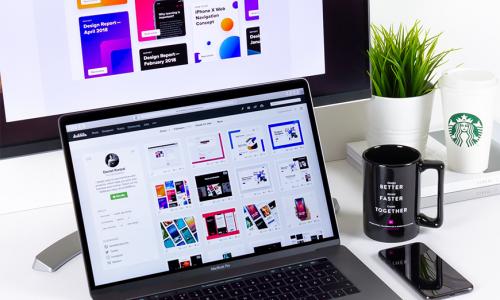
When Stanley Lai, a senior Co-op student, went to an interview, the employer put his resume aside and immediately said, “Show me your portfolio.” This scenario is not uncommon, especially in the design field. Some employers have told us that they will look at students’ portfolios first before even looking at their resumes.
A great portfolio demonstrates your abilities, capabilities, brand and personality, so make sure you put forward your best effort!
From conversations with employers, we’ve been able to gather insight on what’s looked for in online portfolios, and how employers decide who they’re bringing in for interviews. Here are five tips straight from people in the industry:
1. Show Your Best Work
Like the resume, be selective and choose your best work that demonstrates your skills, processes or any other attribute you want to show.
Some employers have said they don’t know where to begin when they go to a website that has 20 design projects in one section. Having too many items will bury the most related and best work.
Ask yourself:
-
What are my best projects?
-
What skills do I want to demonstrate and which projects will reflect that?
-
Which projects relate most to the types of jobs I’m applying for?
2. One Project, One Story
Like your resumes and cover letters, give the reader context for your work and provide the following details:
-
Project background: What was the purpose? Did you work in a team?
-
Role and responsibilities
-
Programs or concepts you used (if it’s relevant)
-
Work process, what you enjoyed most, challenges you overcame, skills developed and how you grew and so on
See Jeffrey Qua’s portfolio for examples of project context.
Many students initially think that giving details of their growth or speaking in a conversational voice will be considered unprofessional. But in reality, the students who are most authentic and speak genuinely about their passions and growth are the ones who stand out over the ones who say what they think the employer wants to hear.
3. Distinguish "We" and "Me"
Many of you often work in team projects and get stuck in explaining projects from a “we” perspective, which is of course great in many contexts. Nonetheless, when you are writing out the project details for your portfolio, be clear on what you did within the group.
Some employers have a hard time understanding what students’ specific contributions were because they wrote, “We came up with the concept, developed drafts for the client and produced the wireframes.” So... what did you do in that whole process?
An easy way to avoid this problem is simply integrating sentences such as, “My responsibilities within the group included producing the initial sketches, acting as the main contact for the client and coming up with the video concept,” and then continuing with the story.
4. Brand Yourself
Do you immediately recognize the cute and funny animals in those Telus ads? Most people recognize a Telus commercial when they see one because they have a certain look, humour and feel to their ads. They have a strong brand.
When students show me their online portfolios and they have the same look and feel as their resume and cover letters, they are applying good branding practices. I can often recognize students just by the logo they create for themselves.
Also, take the extra step and invest in a domain name because it looks more professional. Adam Brayford, the Communications & Marketing Coordinator for Work Integrated Learning, has hired many Co-op students. He said, “Students who take the time to get their own domain name and really stand out. It shows me that they care about their brand.”
Domain names are not expensive and worth the investment if it will help get you the job you want.
5. Avoid Spelling Mistakes
I’m sure students are tired of us saying avoid spelling mistakes, but it still happens far too often. Your portfolio plays a significant part in forming the employer’s first impressions of you and if you have spelling mistakes on it, you are sending a message that you are not detail-oriented or conscious enough about your brand.
Some jobs require good writing ability, so take the time to make sure that there are no spelling mistakes on your site so you look polished and professional.
Apply these tips from industry and you will have an enhanced and amazing portfolio! We will continue to get feedback from a variety of employers and share more tips with you.
If you have any advice or experiences with portfolios, please let us know so we can keep sharing knowledge.















